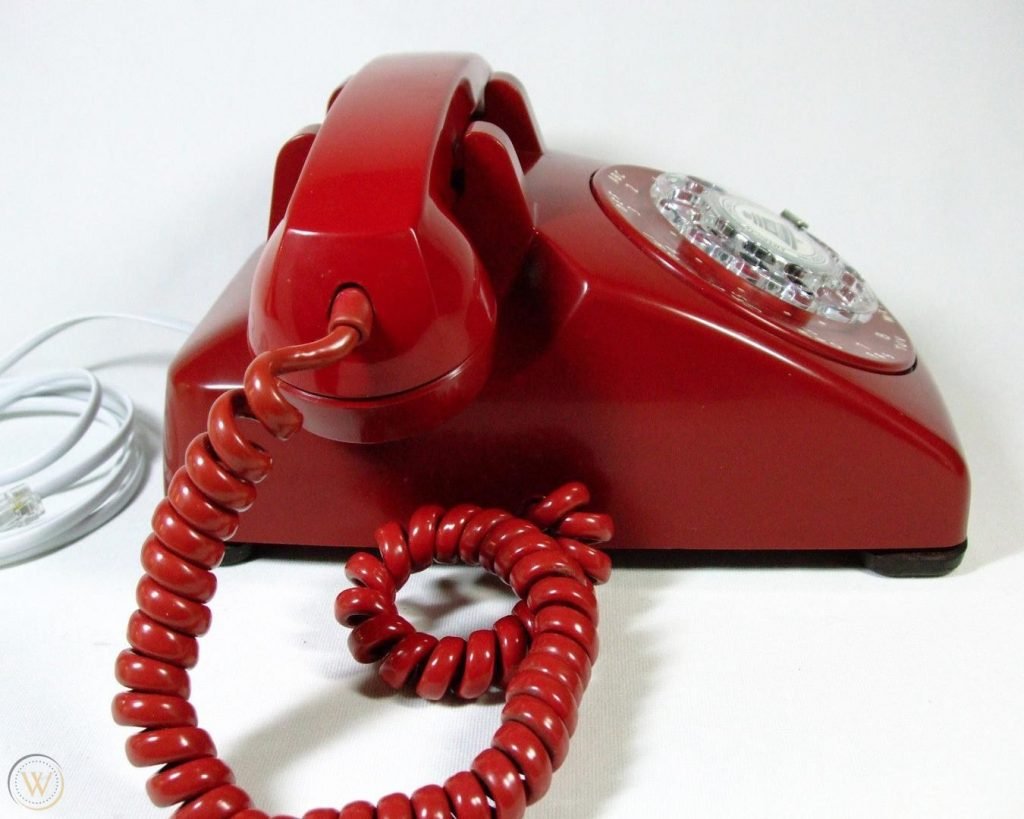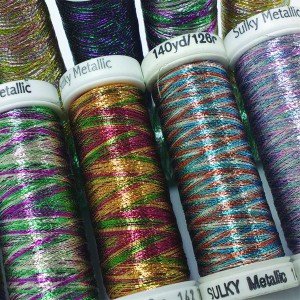As promised, what follows in this new set of blog posts is an accounting of info I found on machine stitching with specialty threads as applied during the creation of “Bright Delight” – with a few extra tidbits thrown in for good measure.
Interested? Read on!
Who hasn’t been tempted to buy a spool or two of those lovely specialty threads?
Such eye popping glittery glam about the size of a lipstick bursting with promises of inspirational fantasies yet to be created:
Metallics cry out to be used!
If the price is right – say, a 2 for 1 sale – they fairly leap their way into a quilter’s shopping basket ready and willing to be experimented with once brought back to one’s sewing space.
And then again, who hasn’t been foiled* by those very same enticing spools?
Machine stitching with these beauties ain’t easy, but they can be tamed for use by everyday quilters like you and like me with a few tricks and tweeks.
It all starts with an understanding of the basic properties of these specialty threads and then progresses towards mastery of their usage.
Let’s begin.
*yep, pun intended!
All threads consist of fiber strands wrapped around a central core. In specialty threads, the core determines the stretchiness of the overall thread itself.
- Rayon core metallics – no stretch
- Polyester or nylon core metallics – various levels of stretchiness
In general, metallics are made by wrapping slivers of metal foil or tinsel around one of those core types. As a final product, metallics aren’t very strong and break easily.

In addition, metallics have a greater propensity towards curling, twisting and tangling than other threads. The basic drape of a thread as it comes off the spool can range from straight, slighty wavy, tangled, or curly like an old-fashioned landline telephone cord! Different manufacturing methods, brands and quality of workmanship all contribute to these variances in threads – affecting specialty and metallics to a significant degree.
Interestingly, the diameter of the spool on which the specialty thread is wound is the most determining factor in the amount of ‘thread memory’ affecting ease of use. ‘Thread memory’ refers to the thread’s permanent wave that tends towards twisting when coming off a spool.
Because metallics ‘keep their coil’ they sew better from a larger spool than from the more tightly wound skinny spools commonly sold in retail stores. And yes, the photo at the head of this post is of several skinny spools of metallic threads I do indeed possess! However, I used an ‘old’ spool of copper metallic thread from my thread stash on my Bright Delight African wall-hanging here recently. Of unknown origin & brand, it also happened to be wound on a larger diameter spool…here’s to the wisdom of the 1990s!
Now quilters, as thrifty, recycling types, I know you are wondering what to do with all those ‘bad’ skinny spools of metallic threads. Seems counter intuitive, but they can be used in the bobbin! ‘Bad’ metallics work well in that application since tension and twisting are not an issue in the bobbin. Furthermore, they can be used with most any type of upper thread.
Of course, rule #1 on sewing with these threads – whether in the bobbin or as an upper thread – is to Sew Slow.
In any case, a special machine set-up for sewing with metallics and specialty threads is essential for successful stitching and will be discussed in greater detail in my next installment: Working with Metallic Threads 2.
(For a nice recap overview of metallic thread characteristics go here)

Ah yes, I’ve been a few rounds with metallic threads myself. I particularly liked your picture of the phone cord! Who doesn’t remember what a mess they could be?
Especially when they got tangled up with us humans!
I bet this is slow going, but beautiful.
Oh yes!
?
While the results are wonderful, what a complicated way to sew. I like your advice: Sew Slow. Kind of applies to daily life sometimes.
Absolutely! And in the case of my working with Metallics, it was a constant reminder for me in all things ‘daily’!
Thanks you for the lesson on metallics. I’ve often looked at them in the store but never had the nerve to try them. Even after reading your tips I still think I will think of them as pretty on the spool and in a basket. I so glad you shared this. 🙂
Perhaps as more tricks and tweeks are revealed in future posts, you might venture out and give them a try. Thanks for stopping by, Cindy!
Wow, sounds complicated.
More attention to detail is involved in using them, so using them should be a deliberate choice knowing they take special care. Kind of like buying a cashmire sweater – not your basic throw in the washer/dryer garment, but wow what a payback in coziness when used & cared for ‘correctly’. Perhaps that’s a dumb analogy, but it’s what popped into my mind right now!
Cozy sweater weather is dawning, maybe that was the root of that analogy!
🙂
I’ve only ever used them for hand stitching and even then they can do the “twist and snarl” …but they are pretty to look at 🙂
They are beauties!
I have used metallic threads several times, and it isn’t easy! I’ve got lots of these shiny little devils hanging out in my sewing studio. They need to be used!
Love that you have begun this series…I have been waiting for it! This intro post is a good read! 🙂
Yeah, those ‘little devils’ as you call them just blithely hop into my cart whilst (I like that British term) walking the fabric store aisles!
Thanks for the enthusiastic feedback on this subject matter…
I’ve never seen thread like this…it’s beautiful. I don’t have the patience to sew because I can never thread the needle. 🙂 This might be easier. I love that phone! I miss the old rotary telephones. When I was a teenager, I remember having a pink princess phone in my room.
I’m not really a patient person, but thank you anyway! I’m more of a ‘persevere-er’.
Lucky you to have your own phone! I can totally see you with a pink princess phone – and a lime green one if that color was ever offered! I took the red phone like the one shown into the dog’s room (also the utility room) whenever I wanted to talk in private…Fraulien loved it!!! (She was a gentle longhaired German Shepard)
So much information, thank you. I learnt a lot and will keep an eye out for fat spools of metallic thread, even though I think I will search in vain. As mentioned before, I think you are very brave to machine stitch with metallics threaded from the top of the sewing machine. (I stick to using them from the bobbin or for hand stitching — coward that I am!) The photograph at the start of your post is beautiful and enticing
Glad to add to your store of sewing notion information.
Being the clever stitcher that you are, you already use these troublesome threads in the bobbin…upside down stitching is a go-to for most experienced sewers. The next post will detail machine set-up that will encourage you (I hope) to try them once again!!! Only as a top thread instead of in the bobbin.
Looking forward to your next post and learning how to do it the right way up !!
I don’t think I’ve ever sewn with the metallic thread but it sure is gorgeous! Haha… I loved your pun 🙂
Janis, I can always count on you to get my punnyness!
I used metallic thread a couple of years ago, and swore “never again”. After reading your post, I might give it another try. Thanks.
Great! But please wait until I’ve finished revealing all the ‘tricks and tweeks’ I discovered – especially with regards to machine set up…
Thanks for stopping by, Chela!
Hi Laura! I can attest that those same metallic threads are a PIA when hand stitching, like cross stitching. Short lengths are best when hand stitching and I’ve never tried them on my sewing machine. Very interesting about using it in the bobbin, though! I look forward to reading Part 2. ~smile~ Roseanne
I wondered about hand-stitching…probably the same #1 Rule applies there, too? “Sew Slow”
😎